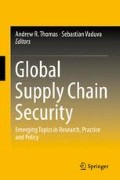Abstract
By some accounts supply chains are increasingly being affected by catastrophic events that disrupt goods flow for prolonged periods. This may be because the occurrence of catastrophic events has, indeed, increased or because we are simply more attuned to such events because global supply chains are exposed to a greater number of catastrophic risks. Regardless of which is true, arguments have been made in the popular press that the impacts of catastrophic events are more severe than in past years because supply chains have less inventory which reduces the amount of time before deliveries to customers are affected. These same accounts argue for managers to return to past practices where more inventory was held, which motivated the analysis in this article of whether such inventory buffers are financially feasible. To broaden the discussion, we also analyzed whether the alternative type of buffer, manufacturing capacity, is feasible. We characterize the feasibility of these two buffer tactics by measuring their effect on manufacturing companies’ net incomes and credit worthiness. We also discuss nonfinancial factors that determine whether capacity and inventory buffers are effective as well as provide some ideas for restructuring supply chains so that less capacity is needed to mitigate the effect of catastrophic disruptions.
Access this chapter
Tax calculation will be finalised at checkout
Purchases are for personal use only
References
Abe S, Hoontrakul P (2012) Fragile supply chains challenged by natural disasters. The Nation, 21 June 2012. http://www.nationmultimedia.com/business/Fragile-supply-chains-challenged-by-natural-disast-30184665.html. Accessed 19 Apr 2013
Bradley JR (2014) An improved method for managing catastrophic supply chain disruptions. Business Horizons July-August 2014, 57(4):483–495
Christopher M, Peck H (2004) The five principles of supply chain resilience. Logist Eur 12(1):16–21
Graves SC, Tomlin B (2003) Process flexibility in supply chains. Manag Sci 49(7):907–919
Hopp WJ, Spearman ML (1996) Factory physics, 3rd edn. Irwin, Chicago
Kachadourian G (2001) Shutdowns likely to continue. Automotive News 75(5948):1
Lapide L (2008) How buffers can mitigate risk. Supply Chain Management Review 12(4):6
Latour A (2001) Trial by fire: a blaze in Albuquerque sets off major crisis for cell-phone giants – Nokia handles supply shock with aplomb as Ericsson of Sweden gets burned – was sisu the difference? The Wall Street Journal, 29 Jan 2001
McGillivray G (2000) Commercial risk under JIT. Canadian Underwriter 67(1):26–30
Palepu KG, Healy PM (2013) Business analysis & valuation: using financial statements, 5th edn. South-Western Cengage Learning, Mason
Richardson J (1993) Parallel sourcing and supplier performance in the Japanese automobile industry. Strateg Manag J 14(5):339–350
Richardson H (1995) Control your costs—then cut them. Transportation Distribution 36(12):94–96
Spear S, Bowen HK (1999) Decoding the DNA of the Toyota production system. Harvard Business Review 77(5):96–106
The Economist (2006) When the chain breaks 379(8482). http://www.economist.com/node/7032258. Accessed 8 May 2014
Tomlin B (2006) On the value of mitigation and contingency: strategies for Managing supply chain disruption risks. Manag Sci 52(5):639–657
Author information
Authors and Affiliations
Corresponding author
Editor information
Editors and Affiliations
Rights and permissions
Copyright information
© 2015 Springer Science+Business Media New York
About this chapter
Cite this chapter
Bradley, J.R. (2015). An Evaluation of Capacity and Inventory Buffers as Mitigation for Catastrophic Supply Chain Disruptions. In: Thomas, A., Vaduva, S. (eds) Global Supply Chain Security. Springer, New York, NY. https://doi.org/10.1007/978-1-4939-2178-2_7
Download citation
DOI: https://doi.org/10.1007/978-1-4939-2178-2_7
Published:
Publisher Name: Springer, New York, NY
Print ISBN: 978-1-4939-2177-5
Online ISBN: 978-1-4939-2178-2
eBook Packages: Business and EconomicsBusiness and Management (R0)

